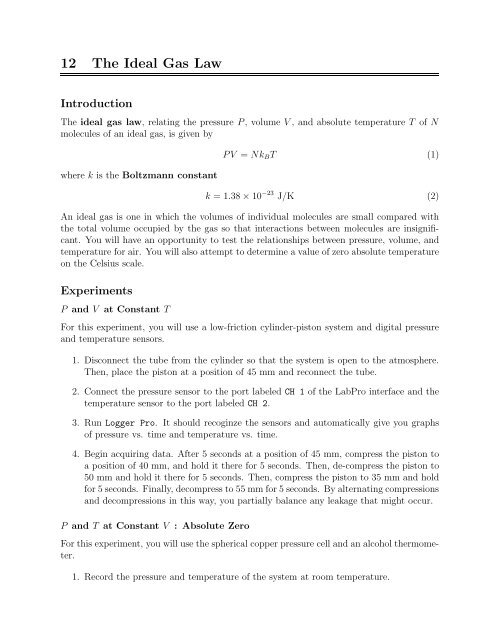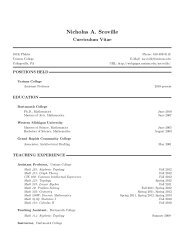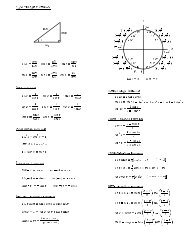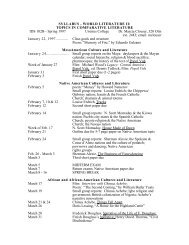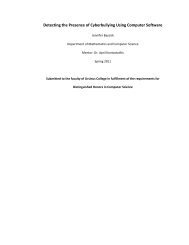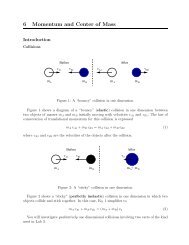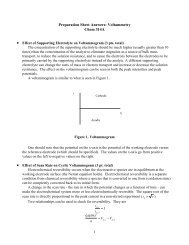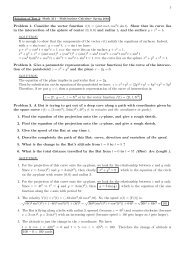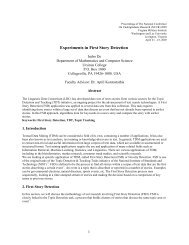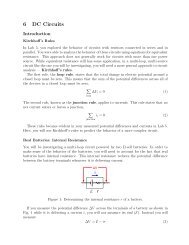You also want an ePaper? Increase the reach of your titles
YUMPU automatically turns print PDFs into web optimized ePapers that Google loves.
<strong>12</strong> <strong>The</strong> <strong>Ideal</strong> <strong>Gas</strong> <strong>Law</strong>Introduction<strong>The</strong> ideal gas law, relating the pressure P, volume V, and absolute temperature T of Nmolecules of an ideal gas, is given bywhere k is the Boltzmann constantPV = Nk B T (1)k = 1.38×10 −23 J/K (2)An ideal gas is one in which the volumes of individual molecules are small compared withthe total volume occupied by the gas so that interactions between molecules are insignificant.You will have an opportunity to test the relationships between pressure, volume, andtemperature for air. You will also attempt to determine a value of zero absolute temperatureon the Celsius scale.ExperimentsP and V at Constant TFor this experiment, you will use a low-friction cylinder-piston system and digital pressureand temperature sensors.1. Disconnect the tube from the cylinder so that the system is open to the atmosphere.<strong>The</strong>n, place the piston at a position of 45 mm and reconnect the tube.2. Connect the pressure sensor to the port labeled CH 1 of the <strong>Lab</strong>Pro interface and thetemperature sensor to the port labeled CH 2.3. Run Logger Pro. It should recoginze the sensors and automatically give you graphsof pressure vs. time and temperature vs. time.4. Begin acquiring data. After 5 seconds at a position of 45 mm, compress the piston toa position of 40 mm, and hold it there for 5 seconds. <strong>The</strong>n, de-compress the piston to50 mm and hold it there for 5 seconds. <strong>The</strong>n, compress the piston to 35 mm and holdfor5seconds. Finally, decompressto55mmfor5seconds. Byalternatingcompressionsand decompressions in this way, you partially balance any leakage that might occur.P and T at Constant V : Absolute ZeroForthis experiment, you will use the spherical copper pressure cell andan alcohol thermometer.1. Record the pressure and temperature of the system at room temperature.
<strong>The</strong> following three steps may be performed in any order. Give thecell time to cool/warm up between steps. Handle the cell only by itsplastic handle. Do not touch the metal parts until it returns to roomtemperature.2. Record the pressure and temperature of the system submerged in boiling water.3. Record the pressure and temperature of the system submerged in ice water.4. Your lab instructor will submerge your cell in in liquid nitrogen. Record the pressure.<strong>The</strong> temperature is approximately −196 ◦ C. Do not put the alcohol thermometerinto the liquid nitrogen!AnalysisP and V at Constant T1. UsetheStatistics button onthetoolbartodetermine thepressure correspondingtoeachcylinder position. Youmayseeevidence ofleakage(agradualtrendbacktowardatmospheric pressure) during compressions and decompressions. In that case, onlyaverage over a short time interval immediately after each compression/decompression.2. Put your pressure and piston position data into two columns in Excel.3. Since you don’t have a precise value for the total volume of the piston chamber andtubing, use only the volume of the piston chamber. You recorded the length of thecylinder under the piston in millimeters. You’ll need to convert this into volume using<strong>The</strong> radius of the cylinder is r = 0.01625±0.00005 m.4. Use Excel to create a graph of V vs.1P .V cylinder = πr 2 h (3)5. Ifyour dataarecompatiblewithalinear model, thenapplyalinear regressionusing theLINEST() function. (<strong>The</strong> absolute value of the y-intercept of your graph correspondsto the volume of the tubing.)P and T at Constant V : Absolute Zero1. Use Excel to create a graph of T vs P. Add a linear fit to the graph.2. Apply a linear regression to your data using the LINEST() function. <strong>The</strong> “y-intercept”ofthisfitcorrespondstoabsolutezeroontheCelsiusscaleaccordingtoanextrapolationof your measurements.
Questions1. Are your P-V data consistent with the ideal gas law? Explain.2. Report your result for absolute zero temperature on the Celsius scale. Is your resultcompatible with the accepted value of −273.25 ◦ C?


